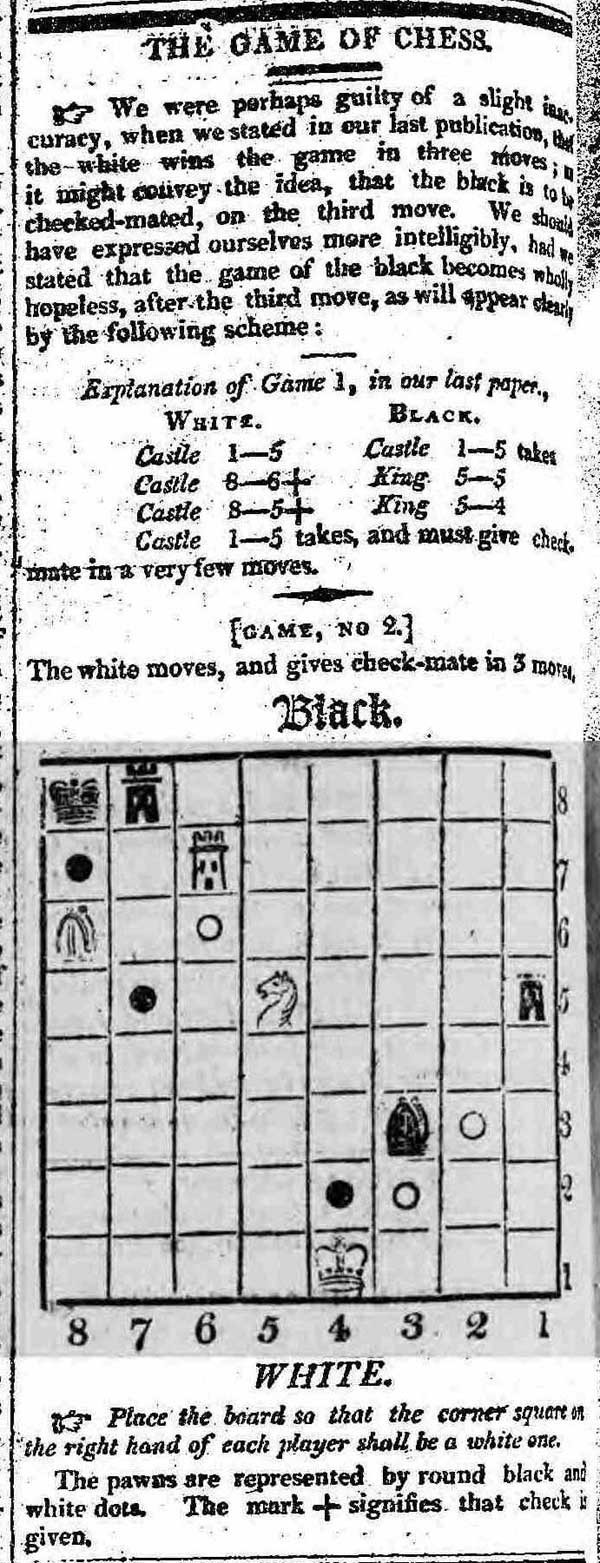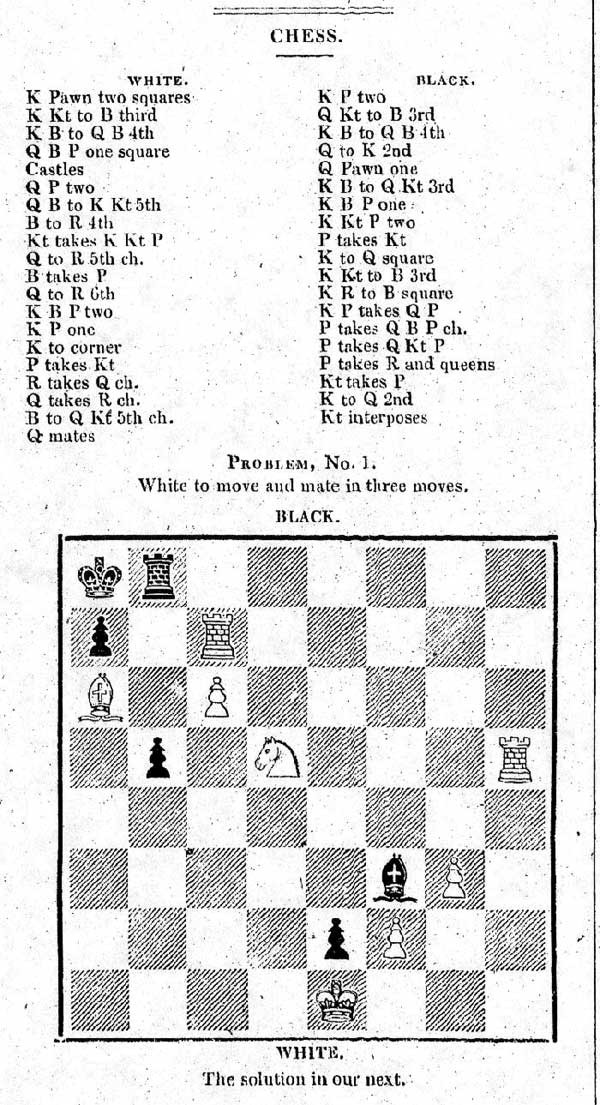|
This article came about in a most curious fashion. I was looking deeply into the "celebrated" (as George Walker called it in 1838) La Bourdonnais - M'Donnell match of 1834. This sniffing around led me into a discussion with a gentleman about the creation of the Westminster Chess Club to which M'Donnell belonged and serendipitously towards the contemporary reporting of the match. It was my original, though unsupported, belief that the 1834 match had been followed by the media, but when asked to provide evidence, I couldn't find much at all in the regular press. Since there were no chess periodicals and, at that point in time, no chess columns in newspapers or magazines, I was at a loss to understand how chess developed so suddenly as it did after that match.
Here is one of the only mentions in the regular press that I found of La Bourdonnais' 1834 visit to London at that time, and it only hints at a possible contest with M'Donnell:
After the match, I found some, though not much, reporting, such as the following in which M'Donnell's name is wrong:
My access to early English papers is somewhat limited and the question in my mind remains whether there was almost no mention of the match or just no mention in the papers I could look through. At any rate, this by-road made me feel that if chess periodicals and chess columns had exsisted at the time, maybe the match between the acknowledged French champion and the man generally considered the strongest player in England would have been covered closely. Then again, maybe such a match and lack of coverage gave impetus to the creation of such periodicals and columns so soon after the match.
Chess books had been around since the invention of the printing press. "Game and Playe of the Chesse," the second book ever printed in the English language, was a chess book. Books (and manuscripts) are more permanant and often considered more dependable, but they are far less immediate and up-to-date. It was about two years after the celebrated match that William Greenwood Walker's book containing the games was published. How much more exciting would it have been for players to have followed the games as the match progressed. So, the importance of periodicals and chess columns can't be overstated.
Now, let's look back at the development of these entities.
The first newspaper chess column appeared in the "Liverpool Mercury" on July 9, 1813 and ended on August 20,1814. As can be seen below in the July 16, 1813 column used a board diagram, but it was unicolored. The chess column was edited by its general editor and founder, Egerton Smith.
This column lasted about a year and it would be another two decades before another newspaper chess column would appear but that one would last four four decades. It was George Walker's column in "Bell's Life in London and Sporting Chronicle."
Walker generally gave a little chess gossip, news, replies to correspondants and annotated games which, at the beginning consisted exclusively of those played at the Westminster Chess Club. The column began in the wake of the 1834 match. M'Donnell, who was the prized member of the Westminster Club was featured in many of the games. Some of the 1834 match games were also given. Walker's notation was fairly conventional as can be seen in this early 1835 example (from Chess Archaeology's Jack O'Keefe Project):

The next chess nespaper column appeared in the "Illustrated London News" on June 25, 1842. In 1845 and the 30 years threreafter Howard Staunton would be the chess editor. Once again from Chess Archaeology's Jack O'Keefe Project, here is what the inaugural column looked like with its sharp notation and nice diagram:


The first chess column to appear in a periodical, oddly enough, was in the weekly medical journal "The Lancet." "The Lancet" first appeared on Oct. 5, 1823 and the first chess column on Oct. 19, 1823 with the title "Origin of the Game of Chess." Subsequent columns would be entitled, "Chess Problems." Although the column is unsigned, twenty year old novice chess-player George Walker has often been creditied with editing this column. "The Lancet," being a high-minded medical magazine, besides publishing medical articles, also published topics, such as drama and chess, that the editors felt contributed to the medical student's intellectual growth. One of the peculiar features of this chess column was that it gave its problems with no diagrams. Below is the first column, followed by a later one.
The first periodical with a focus on chess (although, like many that would follow, also covered other games such as draughts and whist) was the French magazine, ''Le Palamède,'' founded by La Bourdonnais and Joseph Méry in 1836.
Here's an example of its rather bulky notation:

It's interesting to compare its graphics over the years. Here are diagrams from 1836, 1838 and 1842, the first issue of ''Le Palamède" resuscitated by Saint-Amant.
1836

1838

1842

George Walker tried his hand at editing a chess periodical (chess, draughts and whist) in 1838 (the first issue was actually Dec. 1837) with "The Philidorian." His graphics were a much higher quality than those of ''Le Palamède."

There had been a magazine called "The British Miscellany" since the 18th century. In 1841 it incorporated a chess column as one of its many features. It still called itself simply "The British Miscellany," but somewhere shortly after it seemed to have changed it's name to "The British Miscellany and Chess Player's Chronicle." Howard Staunton's name isn't mentioned, but the style of the original articles in "The British Miscellany" is strikingly similar to that of Staunton. "The British Miscellany and Chess Player's Chronicle" seems to have become the "Chess Player's Chronicle" after Staunton took over. This magazine had the distinction of being the first periodical totally focused on chess.
Here is the initial chess article in "The British Miscellany" January, 1841. Its graphics, text and notation are exemplary:


Here is an example from Staunton's "Chess Player's Chronicle," also in 1841. The graphics look almost identical to those in "The British Miscellany.":

Chess and chess reporting seemed to have blossomed from this point on. Maybe they had some limited symbiotic relationship, or maybe it's all a coincidence, but chess reporting, the La Bourdonnais-M'Donnell match and the proliferation of chess play seemed to occurr almost simultaneously in a time when advances and changes as a rule took their own sweet time.
Vive la coïncidence!
|























